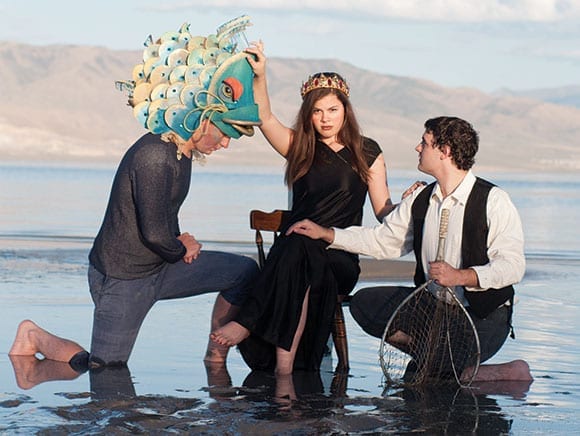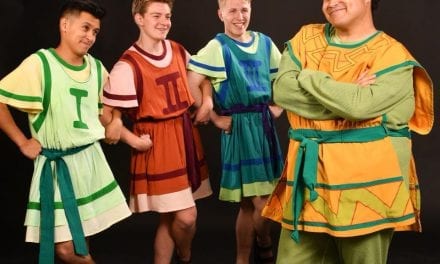PROVO — The Fisherman and His Wife is a participatory play written by Larry and Vivian Snipes. Based on the Grimms’ fairytale, it’s the story of a poor fisherman and his wife, Isabel, who is unhappy with their meager existence. Every day the fisherman goes out to the sea, and every day Isabel tends the garden, makes watery cabbage soup, and hopes that her husband will bring them a fish to eat. One day, the fisherman catches a talking fish who claims to be an enchanted prince. The fisherman sets him free, even though he knows Isabel will be disappointed. Sure enough, when she finds out he let the fish go, she makes the fisherman go back to the sea, summon the fish, and ask him to grant a wish. But when her wish is granted, she is still unhappy, and she sends her husband back time and again with increasingly elaborate wishes.
The BYU Young Company has chosen The Fisherman and His Wife (directed by Nestor Bravo Goldsmith) as one of the touring shows for the 2014-15 season. It features storytellers who guide the audience in small participatory actions, like moving their arms to make waves and snapping their fingers to be crickets.
The interactive parts of this show were very successful. The kokken (silent storytellers meant to guide the audience, played by Rachel Belt and Elissa Nicole Ganowsky) were introduced well at the beginning of the play and were effective in engaging the audience. It was clear when audience members should participate and when they should sit still. There was a phrase that the storytellers repeated every time the fisherman went down to the sea, and it was fun to listen to the other audience members chanting it by the end of the show. There was even a clever stretch break written in at about the halfway point, which undoubtedly helps get the wiggles out.
 Unfortunately, the audience participation was about the only element of the show that was consistent and well executed. First, the script was inconsistent. There were some funny jokes and some really sweet moments, but there were also failed attempts at rhyme, spotty repetition, and some ineffective songs. Sometimes Isabel (Lizzie Mickelsen) complained about her house in rhyme, and sometimes she didn’t. The Storyteller (Mariah Bowles) had random couplets sprinkled throughout the show. The Flounder (Ross Wilcox) sang a little song every time he granted one of the Fisherman’s (Brandon Luke Bringhurst) wishes, but none of the other characters sang. Usually rhyme and repetition are used in story theatre to emphasize morals and themes, but there didn’t seem to be a pattern to it in this show.
Unfortunately, the audience participation was about the only element of the show that was consistent and well executed. First, the script was inconsistent. There were some funny jokes and some really sweet moments, but there were also failed attempts at rhyme, spotty repetition, and some ineffective songs. Sometimes Isabel (Lizzie Mickelsen) complained about her house in rhyme, and sometimes she didn’t. The Storyteller (Mariah Bowles) had random couplets sprinkled throughout the show. The Flounder (Ross Wilcox) sang a little song every time he granted one of the Fisherman’s (Brandon Luke Bringhurst) wishes, but none of the other characters sang. Usually rhyme and repetition are used in story theatre to emphasize morals and themes, but there didn’t seem to be a pattern to it in this show.
The production was further bogged down by a difficult acting style. Bringhurst embraced the exaggerated facial expressions and very specific movements that seemed to be the essence of the style, but Mickelsen, Wilcox, and Emma Traux (who played Flounder’s assistant, a sassy seahorse) didn’t have the same energy. Bowles, Belt, and Ganowsky stayed true to the convention of storytelling, but as a result, I felt like I was watching three different shows at the same time. Occasionally Mickelsen and Wilcox engaged in the style (Isabel kissing the Fisherman goodbye in the morning, Flounder building a castle with his hands, etc.), and those moments were positively delightful. I was desperate for more moments like that.
Donnette Perkins and Shannon McCurdy’s costume designs contributed to the unbalanced feel of the show. Wilcox and Traux were dressed in tie-died t-shirts and jeans while Bringhurst and Mickelsen were dressed as old-timey peasants. Bowles was dressed as a generically nautical person, complete with striped shirt, captain’s hat, and spyglass. It was jarring to go back and forth from tie-dye to breeches. Mickelsen’s later costumes were spectacular (that train on her emperor’s robes!), but they didn’t seem like they came from the same world as the rest of the play.
But I think the production’s biggest downfall was its seeming lack of sincerity. The show opened with a campy, wholly unnecessary introduction and musical number, which left an unpleasantly artificial taste in my mouth. Bowles was over the top, and as Bringhurst was the only actor who was really engaging in the high style, it felt condescending and saccharine. For the first half hour of the show, I was not only unsure sure whether children would sit through it, I wasn’t sure whether I could sit through it. I was worried about how kids would take it right up until the last ten minutes. Yet when Bringhurst’s character hit rock bottom, he, Bowles, and Wilcox became so present. In the climactic scene, Wilcox took Bringhurst’s mask off, helped him stand up, and sent him on his way, all while Bowles looked on with tears in her eyes, and I was truly touched. That sweet sincerity is what the rest of the production was missing. It’s a shame the audience only got to see it for ten minutes.
Nevertheless, I think it’s a show your kids will like. The participation really is a lot of fun, Wilcox is energetic, and Bringhurst has some great comedic moments. It has a nice message, and I think parents could use The Fisherman and His Wife to start some good conversations about the show’s themes. Just be aware that you’ll have to wade through a rough first two-thirds of the show in order to find the heart of the story.






